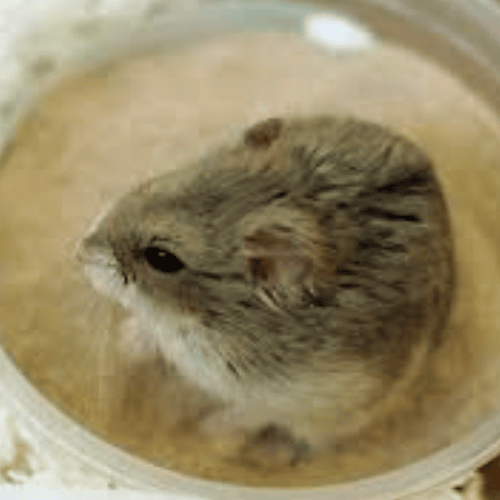If you have recently purchased a hamster, you may wonder whether or not to put sand in the cage that shelters your new pet. Sand playing is a fun activity, but is sand healthy for Hamsters? Do they require the use of reptile sand?
Well, sand is not essential for your Hamster’s survival, but it is quite helpful for keeping them healthy and safe. However, remember one thing, not all sands are appropriate for our hamsters. But some sand types such as reptile sand, are entirely safe for hamsters.

The majority of people who own hamsters find it difficult to select the ideal sand for their pets. If we provide hamsters with sand that isn’t of high enough quality, it might cause them to have serious health problems. It’s crucial to be careful while picking sand for hamsters.
What Is Hamster Sand Bath?
Sand baths offer an alternate, non-hazardous option for keeping your hamster clean. The abrasive nature of the sand helps remove extra particles from your hamster’s coat and can absorb oils and moisture from your hamster’s skin.
In the wild, hamsters utilize sand to maintain their cleanliness; therefore, placing a sand bath in your pet hamster’s cage may stimulate its natural washing instinct! Sand baths are not costly, and chinchilla sand, reptile sand, and even children’s play sand can work just as well.
Dust baths are commonly confused with sand baths, but you need to pay special attention to the substances used in the dust bath since dust baths may cause respiratory issues in your hamster.
Do Hamsters Love Sand Baths?
Some claim that Dwarf hamsters enjoy sand baths more than Syrians. However, reports and studies show it’s more about personality and individual choice.
If you have a hamster that enjoys playing in the sand, giving it a sand bath is not only an effective method for keeping it clean but also offers a lot of fun for you to watch. If your hamster doesn’t like digging its claws into sweet soft sand, try placing rewards beneath the sand to lure it in.
Safe Sand For Hamsters
Our hamsters can only be allowed to play in certain types of sand. Some brands might lead Hamsters to develop severe skin or health concerns.
Each type of sand has a unique set of benefits and drawbacks. As a result, you need to use great caution while selecting the appropriate product for your hamsters.
How Old Are Hamsters At Petco? – Ultimate Guide
Children’s Play Sand
The sand used for children’s play is one of our hamsters’ greatest types of sand. This play sand is made from non-toxic and hypoallergenic materials, making it safe for hamsters. The sands used in this product are processed, washed, and dried before packaging.
The vast majority of these sands have undergone treatment that kills any germs or bacteria that may have been developing in them. If the sand isn’t heated, bake it before offering it to your hamsters.
Sand should be baked at 350–400 degrees Fahrenheit for at least 45 minutes to one hour. Then, before you give the sand to your hamsters, make sure you let it cool down first. As children’s sand is gritty, filter it before providing it to hamsters. You should have no trouble acquiring the package of children’s play sand from any of the local general stores.
Reptile Sand
Reptile sand is an additional excellent option for our Hamsters. It does not include any artificial colors that have been added to it. In addition, it inspires our hamsters to engage in digging activities.
The best environment for our pet hamsters is as close to their natural habitat as possible. This is why you should use ZooSed Reptiand Natural Red Sand Bath. It stimulates the natural burrowing behaviour of many hamsters.
And even though the Zoo Med Retina Natural Red is formulated for reptiles. It is safe to use on hamsters that don’t require salt, and the granules are neither too fine nor too coarse.
Chinchilla Sand
Additionally, some Hamster owners suggest chinchilla sand for Hamsters. You shouldn’t have any trouble locating chinchilla sand in any of the local pet stores. If not, you always have the option of purchasing it online.
Most chinchilla sand is dusty and pricey, harming your hamster and your money. This chinchilla bath dust is created from organic pumice powder and cleans and protects hamsters. You may request a full refund or replacement product if it doesn’t meet your expectations.
Cushing’s Disease in Hamsters – Symptoms, Treatments, And More!
How to Give a Sand Bath to Your Hamster
Sand baths may be constructed from store-bought dishes or sterile, dry containers you already have. Make sure the dish you choose is big enough for your hamster to move around while eating.
Depending on the dish’s depth, fill it in half with sand and place it in the cage. It is always better to put it in a corner if you can, as this will minimize the amount of sand that gets dropped around.
Ensure that you maintain a tight check on the sand since it must be removed and replaced if it becomes contaminated. This will reduce the risk of smells building up over time.
Read this guide for all you need to know about giving hamsters sand baths.
What if My Hammy Ate Sand?
When providing your hamsters with their first sand bath, you must closely check them. It is normal for hamsters to investigate their surroundings by tasting the sand before using it.
Your hamster won’t suffer any ill effects from ingesting this little quantity of sand. You must make sure your Hamster doesn’t continue.
Do Hamsters Require Sand Baths?
You shouldn’t ever give a hamster a bath. Dwarf hamsters appear to like sand baths more than their bigger Syrian counterparts. To properly clean your hamster, you will want a container that is ideal for use as a “bath,” such as a big ceramic bowl, as well as a type of sand that is both sanitary and specifically designed for use with pets, such as chinchilla sand.

Doctor of Veterinary Medicine (D.V.M.) at Nation Taiwan University,Master of Science (M.S.) in Biomedical Engineering at National Taiwan University of Science and Technology





